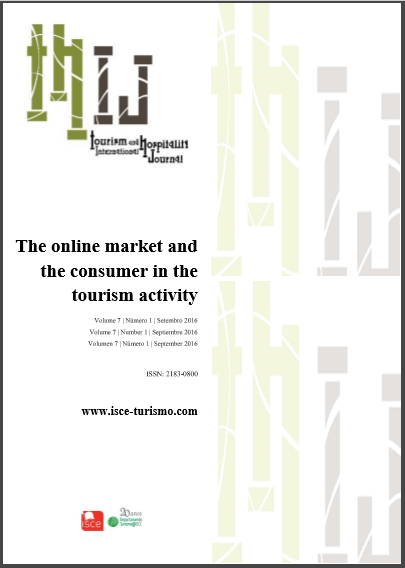Marketing Portugal as a destination through the film A Gaiola Dourada by Rúben Alves
DOI:
https://doi.org/10.57883/thij7(1)2016.30313Keywords:
Semiotics, Film tourism, Destination marketing, Destination marketing strategies, Tourism promotionAbstract
The paper examines the destination marketing opportunities of film tourism through a case study of the Franco-Portuguese movie The Gilded Cage, partly set in the Douro region, in Portugal. The movie, directed by Ruben Alves, was a large box office success in various countries. With this being said, a content analysis was undertaken based on pre-developed categories drawing on discourse analysis of the characters’ statements, descriptions and information provided concerning Portugal and France, as tourism destinations, as well as the study of multimodal language and symbols through images presented. Regarding the predominance of visual communication identified in movies, Kress e van Leeuwen (2001; 2006) refer that this form of communication is another way of interpreting linguistic structures. Given the power of multimodal texts in the dissemination of images and representations of destinations/places, this paper also aims at analysing the audience, tourism markets, film genre, the 3 Ps of film tourism (place, performance and personality), places visited, icons, incorporation of the destinations with the script, the end credits, support provided and audience opinions. Thus, it was found that the film The Guilded Cage (2013) offers diverse destination marketing opportunities that could help increase the potential of the destinations’ visitor markets (Schofield, 2006).
References
Allociné. (2013). Box Office France: Semaine du mercredi 12 juin 2013. Disponível em:http://www.allocine.fr/boxoffice/boxofficedetail_gen_pays=5001.html?date=2013-06-12.
Bakhtin, M. (1990 [1935]). Speech genres and other late essays (V. McGee, Trad.). Austin: University of Texas Press.
Beeton, S. (2005). Film-induced tourism. Clevedon: Channel View Publications.
Carvalho, S. (2013). Film-induced tourism – The case of Portugal. Tese de Mestrado. Aveiro: Universidade de Aveiro.
Carvalho, S., Vieira, A., & Sousa, A. (2013). Film-Induced Tourism – The case of Portugal. Revista AICA, 5, 100-105.
Carvalho, S., Vieira, A., & Sousa, A. (2014). Film-induced tourism: The case of Portugal. Revista Turismo e Desenvolvimento, 21/22(4), 469-482.
Cinémas Gaumont Pathé. (2013) La cage dorée. Disponível em: https://www.youtube.com/watch?v=2sxYb4jMrNk
Dâmaso, P. (2013). Comédia luso-francesa La Cage Dorée conquista portugueses do Luxemburgo. Disponível em: http://www.wort.lu/pt/view/comedia-luso-francesa-la-cage-doree-conquista-portugueses-do-luxemburgo 51910591e4b05a77890756d5
Dawson, C. (2002). Practical research methods – A user-friendly guide to mastering research. Oxford: How to Books.
Donovan, C., & Smolkin, L. (2001). Genre and other factors influencing teacher’s book selections for science instruction. Reading Research Quarterly, 36(4), 412-440.
Eurostat. (2011). Demographic balance, 2011. Disponível em: http://epp.eurostat.ec.europa.eu/statistics_explained/index.php?title=File:Demographic_balance, 2011_(1)_(1_000).png&filetimestamp=20130129110805.
Frost, W. (2006). Braveheart-ed Ned Kelly: Historic films, heritage tourism and destination image. Tourism Management, 27, 247-254.
Gee, J. P. (2000). An introduction to discourse analysis: Theory and method. Londres: Routledge.
Gélin, H., & Galitzine, L. (prod.) & Alves, R. (dir.). (2013). A Gaiola Dourada [Filme]. Paris: Zazi Films, Pathé, TF1, Canal+, Ciné+.
Halliday, M., & Hasan, R. (1993 [1985]). Language, context and text: Aspects of language in a social-semiotics perspective. Vitória: Deakin University Press.
Hudson, S., & Ritchie, J. R. B. (2006). Promoting destinations via film tourism: An empirical identification of supporting marketing initiatives. Journal of Travel Research, 44, 387-396.
Instituto do Cinema e do Audiovisual. (2014). Newsletter Janeiro 2014. Disponível em: http://www.ica-ip.pt/Admin/Files/Documents/contentdoc2533.pdf.
Internet Movie Database. (2013). A Gaiola Dourada. Disponível em: http://www.imdb.com/title/tt2261749.
Iwashita, C. (2006). Media representation of the UK as a destination for Japanese tourists: Popular culture and tourism. Tourist Studies, 6(1), 59-77.
Kothari, C. R. (2004). Research methodology – Methods and techniques (2ª ed.). Deli: New Age International Publishers.
Kress, G., & Van Leeuwen, T. (2006 [1996]). Reading images: The grammar of visual design. Londres e Nova Iorque: Routledge.
Kress, G., & Van Leeuwen, T. (2001). Multimodal discourse: The modes and media of contemporary communication. Londres: Arnold.
Motta-Roth, D., & Nascimento, F. (2009). Transitivity in visual grammar: Concepts and applications. Linguagem & Ensino, 17(5), 319-349
Porto24. Douro mantém «boa procura» de turistas neste verão. (n.d.). Disponível em: http://www.porto24.pt/cidade/douro-mantem-boa-procura-de-turistas-neste-verao.
Riley, R., Baker, D. & Van Doren, C. (1998). Movie induced tourism. Annals of Tourism Research, 25(4), 919-935.
Schofield, P. (1996). Cinematographic images of a city: Alternative heritage tourism in Manchester. Tourism Management, 17(5), 333-34.
Shklovsky, V. (1921 [1965]). Sterne’s Tristram Shandy: Stylistic commentary. In P. Olson (Ed.), Russian formalist criticism – Four essays (pp. 25-57) (L. Lemon & M. Reis, trad.). Lincoln: University of Nebraska Press.
Sousa, A. (2008). Retórica e poder: representações do discurso empresarial em textos multimodais nos media. Organicom, Ano 5: 9, 145-165.
Sousa, A., & Marinho Antunes, L. (2014). Barcelona, Paris, Roma – A promoção de destinos através de traços culturais identitários em trailers de filmes de Woody Allen. THIJ, Tourism and Hospitality International Journal, 3(1), 69-89.
Sousa, A., & Marinho Antunes, L. (2014). Identidade e cultura: Representações do destino Portugal. In C. Costa, F. Brandão, R. Costa & Z. Breda (Eds.), Produtos e competitividade do turismo na lusofonia (pp. 139-153), 2, Cap. 9. Lisboa: Escolar Editora.
Tendinha, R. P. Uma família portugaise, com certeza, (n.d.). Disponível em: www.dn.pt/revistas/nm/interior.aspx?content_id=3189677.
Voisin, J. (2004). Comunicação turística, memória, identidade: Uma proposta de abordagem e dois casos (Ilhéus-Bahia e La Rochelle-França). Revista do Espaço Académico, 37, Junho de 2004 [online], http://www.espacoacademico.com.br.
White, P. (1995). Geography, literature and migration. In J. Connell, R. King & P. White (Eds.), Writing across worlds: Literature and migration (pp. 1-27). Londres: Routledge.
Zimmermann, S., & Reeves, T. (2009). Film tourism – Locations are the new stars. In R. Conrady & M. Buck (Eds.), Trends and issues in global tourism 2009 (pp. 155-162). Berlin: Springer.
Downloads
Published
How to Cite
Issue
Section
License
Copyright (c) 2023 This work is licensed under a Creative Commons - Attribution 4.0 International (CC BY 4.0)

This work is licensed under a Creative Commons Attribution 4.0 International License.
This work is published under the Creative Commons Attribution 4.0 International License.






